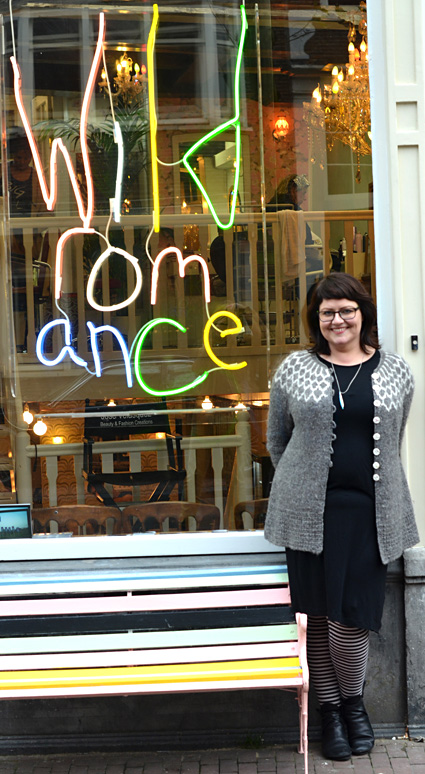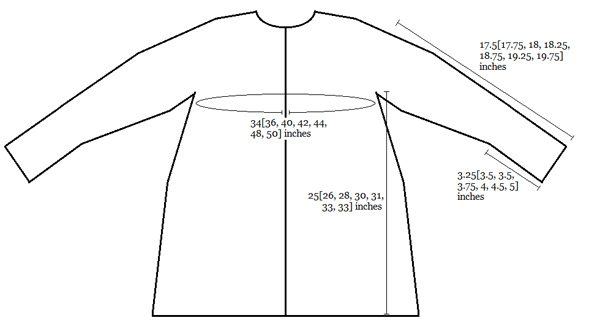

|
|
|

I spend a lot of my time talking about, thinking about, writing about and looking at different types of the iconic Icelandic Lopi sweaters. I travel the world teaching my classes, I wear them almost every day and I'm always thinking of new ways to improve fit and function of this amazingly versatile garment. |
||
|
|
 |
Tweet
 |
|
SIZE |
|
|
FINISHED MEASUREMENTS |
|
MATERIALS Yarn Ístex Léttlopi (Light Lopi) [100% wool; 109yd/100m per 50g skein]; color Kits for this sweater are available here. See Pattern Notes regarding yarn substitution. Recommended needle size [always use a needle size that gives you the gauge listed below -- every knitter's gauge is unique] (or use 32-inch needle and magic-loop method to knit the whole sweater) Notions
GAUGE |
|
PATTERN NOTES |
|
Lopi yarn has unique qualities that make the steeking method described here work. If you are choosing alternative yarn, consider machine-sewing your steek first. This article may be of assistance. Ribbing (worked in the round): Ribbing (worked back and forth): All increases in yoke are worked as backward loop increases (e-wraps) |
The chart for this pattern is very large and fits on a letter-sized page. Click here and print the resulting page. |
|
DIRECTIONS Join yoke to begin working in the round, being careful not to twist work, and CO 1 st at beg of rnd for steek. This st will be purled all the way down to ribbing. Work all other stitches in stockinette (K all sts). After working all increases in the chart, you should have 260[276, 300, 308, 324, 356, 372] sts on your needles. 100[106, 115, 118, 124, 136, 142] sts increased. Shape back with short rows: Work 0[0, 2, 3, 4, 4, 5] more rnds.
Divide work into body and sleeves: BODY SLEEVES (two options given below) Right sleeve: With RS facing, work 20[20, 21, 22, 22, 25, 25] sts, place marker (M1). Work until you reach the underarm sts. Pick up and knit 10[10, 10, 12, 12, 14, 14] sts to complete the circle, place marker (M2) at mid underarm, i.e. after picking up 5[5, 5, 6, 6, 7, 7] of the sts. You should now have 64[66, 70, 74, 76, 88, 90] sts on the needles. Rep Short rows 3 and 4 one more time. Short row 5 [RS]: YO, k to 3 sts before YO, turn work. Rep Short rows 5 and 6 one more time. Resume working in the round. Work sleeve until it measures 14.25[14.25, 14.5, 14.5, 14.75, 14.75, 14.75] inches from underarm. Work ribbing in the round 3.25[3.5, 3.5, 3.75, 4, 4.5, 5] inches. Bind off. |
|
FINISHING Weave in all ends. Before steeking, wash the sweater in lukewarm water with mild wool soap and lay flat to dry. A trick to make your lopi sweater soft is to add hair conditioner to the last rinsing water (about two times the amount you would use for your hair). Let the sweater soak for 5 minutes and don't rinse it out. Crochet steek: Adding buttonholes: This tutorial may be helpful. |
 |
| ABOUT THE DESIGNER |
|
Ragga is a mother, grandmother, a passionate knitting entrepreneur and a nurse. She is the owner of Knitting Iceland, the fun and funky tour operator that brings knitters from all over the world to Iceland. Ragga LOVES knitting, spinning, running and cooking but really dislikes red beets and goat cheese. Check out Ragga's Top-down Icelandic Sweater class on Craftsy. Most of the techniques for Iðunn are covered there -- plus you'll learn fun things about Icelandic sheep, wool and knitting! You'll find more of her work on Ravelry.
|
|
Pattern & images © 2012 Ragga Eiriksdottir. Contact Ragga |